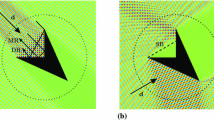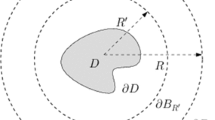Abstract
In this paper we address several theoretical questions related to the numerical approximation of the scattering of acoustic waves in two or three dimensions by penetrable non-homogeneous obstacles using convolution quadrature (CQ) techniques for the time variable and coupled boundary element method/finite element method for the space variable. The applicability of CQ to waves requires polynomial type bounds for operators related to the operator Δ − s 2 in the right half complex plane. We propose a new systematic way of dealing with this problem, both at the continuous and semidiscrete-in-space cases. We apply the technique to three different situations: scattering by a group of sound-soft and -hard obstacles, by homogeneous and non-homogeneous obstacles.
Similar content being viewed by others
References
Bachelot A., Bounhoure L., Pujols A.: Couplage éléments finis-potentiels retardés pour la diffraction électromagnétique par un obstacle hétérogène. Numer. Math. 89(2), 257–306 (2001)
Bamberger A., Duong T.H.: Formulation variationnelle espace-temps pour le calcul par potentiel retardé de la diffraction d’une onde acoustique. I. Math. Methods Appl. Sci. 8(3), 405–435 (1986)
Bamberger A., Duong T.H.: Formulation variationnelle pour le calcul de la diffraction d’une onde acoustique par une surface rigide. Math. Methods Appl. Sci. 8(4), 598–608 (1986)
Becache E., Ha-Duong T.: A space-time variational formulation for the boundary integral equation in a 2D elastic crack problem. RAIRO Modél. Math. Anal. Numér. 28(2), 141–176 (1994)
Calvo M.P., Cuesta E., Palencia C.: Runge-Kutta convolution quadrature methods for well-posed equations with memory. Numer. Math. 107(4), 589–614 (2007)
Carstensen C., Funken S.A.: Coupling of nonconforming finite elements and boundary elements. I. A priori estimates. Computing 62(3), 229–241 (1999)
Chapko R., Kress R.: Rothe’s method for the heat equation and boundary integral equations. J. Integr. Equ. Appl. 9(1), 47–69 (1997)
Costabel, M.: Symmetric methods for the coupling of finite elements and boundary elements. In: Boundary Elements IX, vol. 1 (Stuttgart, 1987), pp. 411–420. Comput. Mech., Southampton (1987)
Costabel M.: Boundary integral operators on Lipschitz domains: elementary results. SIAM J. Math. Anal. 19(3), 613–626 (1988)
Costabel M.: Time-dependent problems with the boundary integral equation method. In: Stein, E., Borst, R., Hughes, T.(eds) Encyclopedia of Computational Mechanics, chap. 22, Wiley, New York (2003)
Costabel M., Stephan E.: A direct boundary integral equation method for transmission problems. J. Math. Anal. Appl. 106(2), 367–413 (1985)
Cuesta E., Lubich C., Palencia C.: Convolution quadrature time discretization of fractional diffusion-wave equations. Math. Comput. 75(254), 673–696 (2006)
Dautray, R., Lions, J.-L.: Mathematical analysis and numerical methods for science and technology, vol. 5. Springer, Berlin (1992). Evolution problems. I. With the collaboration of Michel Artola, Michel Cessenat and Hélène Lanchon
Davies P.J., Duncan D.B.: Stability and convergence of collocation schemes for retarded potential integral equations. SIAM J. Numer. Anal. 42(3), 1167–1188 (2004)
Ha-Duong, T.: On retarded potential boundary integral equations and their discretisation. In: Topics in Computational Wave Propagation. Lect. Notes Comput. Sci. Eng., vol. 31, pp. 301–336. Springer, Berlin (2003)
Ha-Duong T., Ludwig B., Terrasse I.: A Galerkin BEM for transient acoustic scattering by an absorbing obstacle. Int. J. Numer. Methods Eng. 57(13), 1845–1882 (2003)
Hackbusch, W., Kress, W., Sauter, S.A.: Sparse convolution quadrature for time domain boundary integral formulations of the wave equation by cutoff and panel-clustering. In: Boundary Element Analysis. Lect. Notes Appl. Comput. Mech., vol. 29, pp. 113–134. Springer, Berlin (2007)
Hairer, E., Wanner, G.: Solving ordinary differential equations II. Stiff and Differential-Algebraic Problems. Springer Series in Computational Mathematics, vol. 14, 2nd edn. Springer, Berlin (1996)
Han H.D.: A new class of variational formulations for the coupling of finite and boundary element methods. J. Comput. Math. 8(3), 223–232 (1990)
Hohage T., Sayas F.-J.: Numerical solution of a heat diffusion problem by boundary element methods using the Laplace transform. Numer. Math. 102(1), 67–92 (2005)
Kress W., Sauter S.: Numerical treatment of retarded boundary integral equations by sparse panel clustering. IMA J. Numer. Anal. 28, 162–185 (2008)
Laliena, A.R., Rapún, M.-L., Sayas, F.-J.: Symmetric boundary integral formulations for Helmholtz transmission problems. Appl. Numer. Math. (2009, in press)
Laliena, A.R., Sayas, F.-J.: Algorithmic aspects of RK-based convolution quadrature with an application to the scattering of waves (in preparation)
Laliena, A.R., Sayas, F.-J.: A distributional version of Kirchhoff’s formula. J. Math. Anal. Appl. (in revision)
Lubich C.: Convolution quadrature and discretized operational calculus. I. Numer. Math. 52(2), 129–145 (1988)
Lubich C.: Convolution quadrature and discretized operational calculus. II. Numer. Math. 52(4), 413–425 (1988)
Lubich C.: On the multistep time discretization of linear initial-boundary value problems and their boundary integral equations. Numer. Math. 67(3), 365–389 (1994)
Lubich C.: Convolution quadrature revisited. BIT 44(3), 503–514 (2004)
Lubich C., Ostermann A.: Runge-Kutta methods for parabolic equations and convolution quadrature. Math. Comput. 60(201), 105–131 (1993)
Lubich C., Schneider R.: Time discretization of parabolic boundary integral equations. Numer. Math. 63(4), 455–481 (1992)
Martensen E.: The Rothe method for the wave equation in several space dimensions. Proc. R. Soc. Edinb. Sect. A 84(1–2), 1–18 (1979)
McLean W.: Strongly Elliptic Systems and Boundary Integral Equations. Cambridge University Press, Cambridge (2000)
Monk P., Wang X., Wildman R., Weile D.: A finite difference delay modeling approach to the discretization of the time domain integral equations of electromagnetics. IEEE Trans. Antennas Propag. 56(8), 2442–2452 (2008)
Sayas, F.-J.: Direct boundary element methods with discretization of all integral operators. In: Integral Methods in Science and Engineering: Techniques and Applications, pp. 217–226. Birkhäuser Boston, Boston (2007)
Schädle A., López-Fernández M., Lubich C.: Fast and oblivious convolution quadrature. SIAM J. Sci. Comput. 28(2), 421–438 (2006)
Schanz M.: Wave Propagation in Viscoelastic and Poroelastic Continua: A Boundary Element Approach. Lecture Notes in Applied and Computational Mechanics. Springer, New York (2001)
Schwartz L.: Méthodes mathématiques pour les sciences physiques. Enseignement des Sciences.. Hermann, Paris (1961)
Sheen D., Sloan I.H., Thomée V.: A parallel method for time discretization of parabolic equations based on Laplace transformation and quadrature. IMA J. Numer. Anal. 23(2), 269–299 (2003)
Steinbach O.: Fast solution techniques for the symmetric boundary element method in linear elasticity. Comput. Methods Appl. Mech. Eng. 157(3–4), 185–191 (1998)
Author information
Authors and Affiliations
Corresponding author
Rights and permissions
About this article
Cite this article
Laliena, A.R., Sayas, FJ. Theoretical aspects of the application of convolution quadrature to scattering of acoustic waves. Numer. Math. 112, 637–678 (2009). https://doi.org/10.1007/s00211-009-0220-z
Received:
Revised:
Published:
Issue Date:
DOI: https://doi.org/10.1007/s00211-009-0220-z




